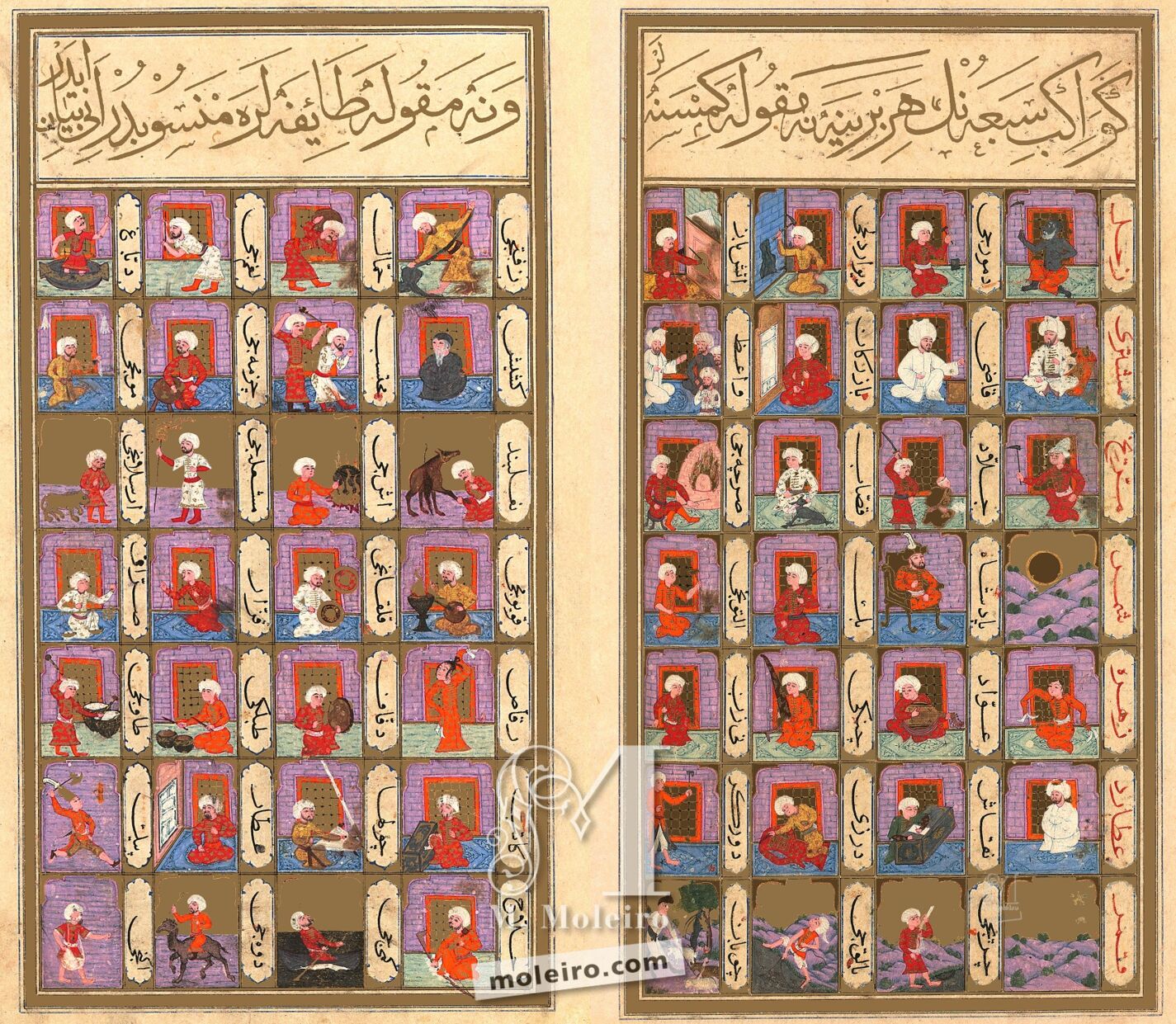
This double-page spread includes a total of fifty-six vignettes; each vignette is accompanied by a title written vertically inside a cartouche to the right of the illustration. To read the page correctly one must start in the upper right corner, which represents Saturn, the most distant planet from Earth according to Arab astronomers, and continue horizontally across the double-page showing the seven different professions associated with this planet. The second row, always read from right to left, refers to the planet Jupiter and its seven professions. The third row belongs to Mars, followed by the Sun, Venus, Mercury and finally the Moon in the correct descending order. The iconography of the seven planets is already familiar from the section on the twelve signs of the zodiac included in Abu Macshar’s Treatise of Nativities (ff. 8v-30v): Saturn as a black man with a pick; Jupiter sitting dignified and cross-legged leaning on a cushion; Mars with an axe and wearing a military helmet; Venus as a female dancer holding handkerchiefs in her hands; and Mercury as a scribe kneeling on the floor. The Sun and the Moon are not personified in these vignettes, having been naturalistically illustrated as a solar disk rising from a hilly landscape and a simple landscape with no indication of the lunar planet. Most of the miniatures, including those representing the planets, are set in an indoor space and the background is provided by a grilled window surrounded by a bricked wall. There are also several open-air scenes when so required by the profession illustrated, using a gold sky as the backdrop for the figure. Notwithstanding their small size, each illustration is carefully drawn in an effort to meticulously depict the person engaged in the profession described in the title.
Saturn is the planet associated with unhealthy, dangerous, tiresome and generally lowly and unpleasant jobs, such as those of the stone mason or the tanner. Jupiter, however, is the wise planet that oversees professions concerning lawmaking and religious matters (the judge, the preacher, the monk) and money making (merchant, market inspector), although his association with bootmakers and candlemakers is unclear. Mars the warrior planet, is always involved in some kind of bloody or heroic activity (executioner, lion-tamer) or fire-related professions (cook, glazier, torchbearer). The Sun, the ruler of course, is therefore associated with authority (the sultan, the bey) and everything that shines, from gold to silver, from money to reflective shields and silk threads. Venus, a female planet, is always a musician or dancer. Interestingly, the painter represented only the planet andthe dancer as female figures: the musicians are all males. Mercury presides over several “clean” jobs, beginning with the important activities of the scribe and the miniaturist, continuing with the tailor, the weaver and the pharmacist and ending with an interesting association with the messenger, perhaps an indirect reference to the Greek origin of Mercury/Apollo as the messenger of the gods. Finally, the Moon the image of which is strangely missing in the hilly landscape perhaps because the new moon is intended to be represented is mostly associated with outdoor activities (linen bleacher, shepherd), travel (camel driver), water (fisherman, sailor) and agriculture (sower), whilst the cotton carder is the only indoor profession but probably also related to agriculture.
Stefano Carboni
The Metropolitan Museum of Art
Curatorial Assistant in Islamic Art
(Fragment of the Book of Felicity commentary volume)